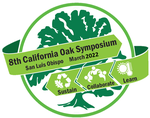#14

Rosi Dagit, RCD of the Santa Monica Mountains
The 150,000 acre Santa Monica Mountains National Recreation Area (SMMNRA) is a complex mosaic of private and public lands. However, our native oak and riparian woodlands provide ecosystem services and benefits that cross jurisdictional boundaries and function as an integrated whole. Threats from drought, wildfire, climate change, and invasive species are distributed across the entire landscape. Tree species that currently occupy the SMMNRA have a proven ability to survive cyclic climate changes, as well as the cycle of annual summer drought that defines Mediterranean climates. From this perspective, questions of tree species persistence in the SMMNRA can be framed by how much change these trees can tolerate, rather than modeling shifts in ideal conditions.
Local city, county, state and federal agencies individually regulate management of their woodlands. This project provided a coordinated effort to anticipate effects of climate change to develop strategies for restoring and expanding native oak and riparian woodlands into the future. With assistance from the NASA DEVELOP team, we developed interactive maps that identify sites of high, moderate and low vulnerability to climate change that provide the basis for designating management units for native tree species. These maps identify existing geographic locations where woodland assemblages are anticipated to persist under future climate change conditions to enhance carbon storage and ecosystem services benefits, as well as areas that are anticipated to be able to support trees in the future.
The Los Angeles County Native Tree Priority Planting Plan (2019) articulates strategies to maintain biodiversity and resiliency of local trees and woodlands that provide critical habitat and linkage connectivity as climate change creates significant stressors to their long-term survival. This blueprint will help guide a coordinated, inter-jurisdictional approach leveraging required mitigation planting with voluntary restoration.
